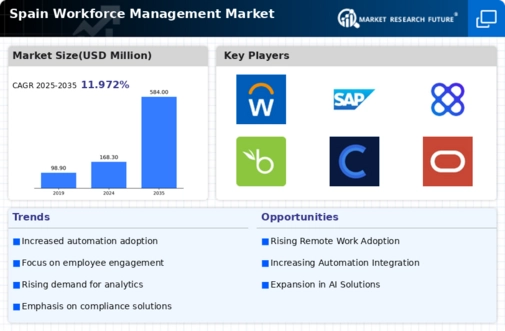Shift Towards Remote Work Models
The workforce management market in Spain is adapting to the growing trend of remote work models. As organizations embrace flexible working arrangements, there is a heightened need for effective management of remote teams. This shift has led to an increased demand for workforce management solutions that facilitate communication, performance tracking, and project management across distributed teams. According to recent studies, approximately 30% of the workforce in Spain is now engaged in remote work, a figure that is expected to rise. This trend suggests that companies are prioritizing tools that support remote collaboration and productivity, thereby reshaping the landscape of workforce management in the country.
Rising Importance of Data Security
Data security has emerged as a critical driver in the workforce management market in Spain. With the increasing reliance on digital solutions for managing employee information, organizations are becoming more aware of the potential risks associated with data breaches. The implementation of the General Data Protection Regulation (GDPR) has heightened the focus on data privacy, compelling companies to adopt robust security measures. As a result, there is a growing demand for workforce management systems that prioritize data protection and compliance. Organizations are investing in solutions that offer secure data storage and access controls, which is likely to influence purchasing decisions in the workforce management market. This trend underscores the importance of safeguarding sensitive employee information in an increasingly digital landscape.
Regulatory Compliance and Labor Laws
In Spain, the workforce management market is significantly influenced by stringent regulatory compliance and evolving labor laws. Organizations must navigate complex legal frameworks that govern employee rights, working hours, and compensation. The implementation of the new labor regulations has compelled businesses to adopt advanced workforce management solutions to ensure compliance. Failure to adhere to these regulations can result in substantial fines, which may reach up to €1 million for serious violations. Consequently, companies are increasingly investing in workforce management systems that provide tools for tracking compliance and managing employee records effectively. This focus on regulatory adherence is likely to drive the demand for innovative solutions within the workforce management market.
Focus on Employee Training and Development
In the context of the workforce management market, there is a growing emphasis on employee training and development in Spain. Organizations are recognizing that investing in their workforce is crucial for maintaining competitiveness. As a result, many companies are implementing comprehensive training programs aimed at upskilling employees. This trend is reflected in the increasing allocation of budgets towards workforce development initiatives, with an estimated 15% of total HR budgets now dedicated to training. By enhancing employee skills, organizations not only improve productivity but also foster a culture of continuous learning. This focus on development is likely to drive the demand for workforce management solutions that incorporate training modules and performance tracking.
Technological Advancements in Workforce Management
The workforce management market in Spain is experiencing a notable transformation due to rapid technological advancements. The integration of artificial intelligence (AI) and machine learning (ML) into workforce management solutions is enhancing operational efficiency. These technologies enable organizations to optimize scheduling, improve employee engagement, and streamline communication. As of 2025, the market is projected to grow at a CAGR of approximately 10%, driven by the increasing demand for automation in workforce processes. Companies are investing in sophisticated software that can analyze workforce data in real-time, allowing for better decision-making. This trend indicates a shift towards more data-driven approaches in managing human resources, which is likely to redefine traditional workforce management practices.


















Leave a Comment